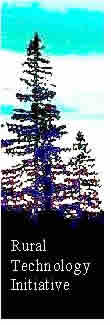
Case studies examining the economic impact
of the "Forests and Fish" rules on NIPF Landowners
By
Kevin Zobrist, UW-CFR
Graduate Student
In response to the
listing of salmon under the Endangered Species Act (ESA), a caucus
of federal and state agencies, industry, non-industrial private
landowners, and Native American tribes developed a new Forests and
Fish Agreement. New forest practice rules affecting riparian zones
have been developed from this agreement to meet the requirements of
the ESA and Clean Water Act. The rules for Western Washington
established riparian buffer for fish-bearing streams that extends to
approximately 170 feet (depending on the site) on either side of the
stream. The buffer is divided into 3 zones as follows:
- Core Zone: No harvesting allowed.
- Inner Zone: Partial harvest is allowed under two
options if minimum basal area requirements to meet Desired Future
Condition (DFC) are met.
Option 1: Thin
From Below
Option 2: Leave trees closes to
the stream ("whack and pack")
- Outer Zone: Harvest is allowed, but 20 trees per acre
of 12" in diameter must be retained.
The purpose of this
study is to examine the economic impacts of these riparian buffers
on small, non-industrial private forest (NIPF) landowners, and
specifically to examine the extent and disparity of these impacts.
The SBEIS (Small Business Economic Impact Statement) has already
looked at the average impacts on NIPF landowners, but this only
tells part of the story. With these case studies, we are able to
gain a more detailed perspective on how small landowners are
impacted, where they are falling in relation to this average, and
what sort of disparity is created. It is important to go beyond
statistical averages and look in depth at how actual landowners are
impacted by the new rules, what factors drive those impacts, and
what can be done to mitigate those impacts. Several NIPF landowners
in Lewis County, WA have volunteered their property for use in this
study.
For each case study, management of the property is simulated
using GIS and computer growth models for five different
scenarios:
- Baseline scenario - management under the previous forest
practice regulations
- Forests/Fish rules with no harvest in the riparian zone
- Forests/Fish rules with harvest included in the outer zone
- Forests/Fish rules with harvest in the outer zone and partial
removal in the inner zone under option 1
- Forests/Fish rules with harvest in the outer zone and partial
removal in the inner zone under option 2
An economic
analysis is done to compute the estimated timber value, bare land
value, and total forest value for each scenario. The results of the
Forests and Fish scenarios can then be compared to the baseline
scenario to examine the incremental impact of the new requirements.
It is hoped that from these case studies best strategies for small
landowners will emerge. Three case studies have been completed so
far.
continued on next page...
|









